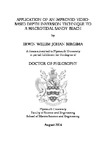Application of an improved video-based depth inversion technique to a macrotidal sandy beach
| dc.contributor.supervisor | Conley, Daniel Charles | |
| dc.contributor.author | Bergsma, Erwin Willem Johan | |
| dc.contributor.other | School of Biological and Marine Sciences | en_US |
| dc.date.accessioned | 2017-03-29T13:21:38Z | |
| dc.date.available | 2017-03-29T13:21:38Z | |
| dc.date.issued | 2017 | |
| dc.date.issued | 2017 | |
| dc.identifier | 10420168 | en_US |
| dc.identifier.uri | http://hdl.handle.net/10026.1/8736 | |
| dc.description.abstract |
Storm conditions are considered the dominating erosional mechanism for the coastal zone. Morphological changes during storms are hard to measure due to energetic environmental conditions. Surveys are therefore mostly executed right after a storm on a local scale over a single or few storms [days to weeks]. The impact of a single storm might depend on the preceding sequence of storms. Here, a video camera system is deployed in the South-West of England at the beach of Porthtowan to observe and assess short-term storm impact and long-term recovery. The morphological change is observed with a state-of-the-art video-based depth estimation tool that is based on the linear dispersion relationship between depth and wave celerity (cBathy). This work shows the first application of this depth estimation tool in a highly energetic macrotidal environment. Within this application two sources of first-order inaccuracies are identified: 1) camera related issues on the camera boundaries and 2) fixed pixel location for all tidal elevations. These systematic inaccuracies are overcome by 1) an adaptive pixel collection scheme and camera boundary solution and 2) freely moving pixels. The solutions together result in a maximum RMS-error reduction of 60%. From October 2013 to February 2015 depths are hourly estimated during daylight. This period included, the 2013-2014 winter season which was the most energetic winter since wave records began. Inter-tidal beach surveys show 200 m3/m erosion while the sub-tidal video derived bathymetries show a sediment loss of around 20 m3/m. At the same time the sub-tidal (outer) bar changes from 3D to linear due to a significant increase in alongshore wave power during storm conditions. Complex-EOF based storm-by-storm impact reveals that the individual storm impact at Porthtowan can be described as a combined function of storm-integrated incident offshore wave power [P] and disequilibrium and that the tidal range has limited effect on the storm impact. The inter- and sub-tidal domain together gain volume over the 2013-2014 winter and the two domains show an interactive inverse behaviour indicating sediment exchange during relatively calm summer conditions. The inter-tidal domain shows accelerated accretion during more energetic conditions in fall 2014. The outer bar slowly migrated onshore until more energetic wave conditions activate the sub-tidal storm deposits and 3 dimensionality is reintroduced. The inter-tidal beach shows full recovery in November 2014, 8 months after the stormy winter. | en_US |
| dc.description.sponsorship | Research Excellence Framework | en_US |
| dc.language.iso | en | |
| dc.publisher | University of Plymouth | |
| dc.rights | Attribution-NonCommercial-ShareAlike 3.0 United States | * |
| dc.rights.uri | http://creativecommons.org/licenses/by-nc-sa/3.0/us/ | * |
| dc.subject | cBathy | en_US |
| dc.subject | Depth Inversion | en_US |
| dc.subject | Nearshore | en_US |
| dc.subject | Video | en_US |
| dc.subject | Porthtowan | en_US |
| dc.subject | Cornwall | en_US |
| dc.subject.classification | PhD | en_US |
| dc.title | Application of an improved video-based depth inversion technique to a macrotidal sandy beach | en_US |
| dc.type | Thesis | |
| plymouth.version | publishable | en_US |
| dc.identifier.doi | http://dx.doi.org/10.24382/550 | |
| dc.rights.embargoperiod | No embargo | en_US |
| dc.type.qualification | Doctorate | en_US |
| rioxxterms.version | NA |
Files in this item
This item appears in the following Collection(s)
-
01 Research Theses Main Collection
Research Theses Main



